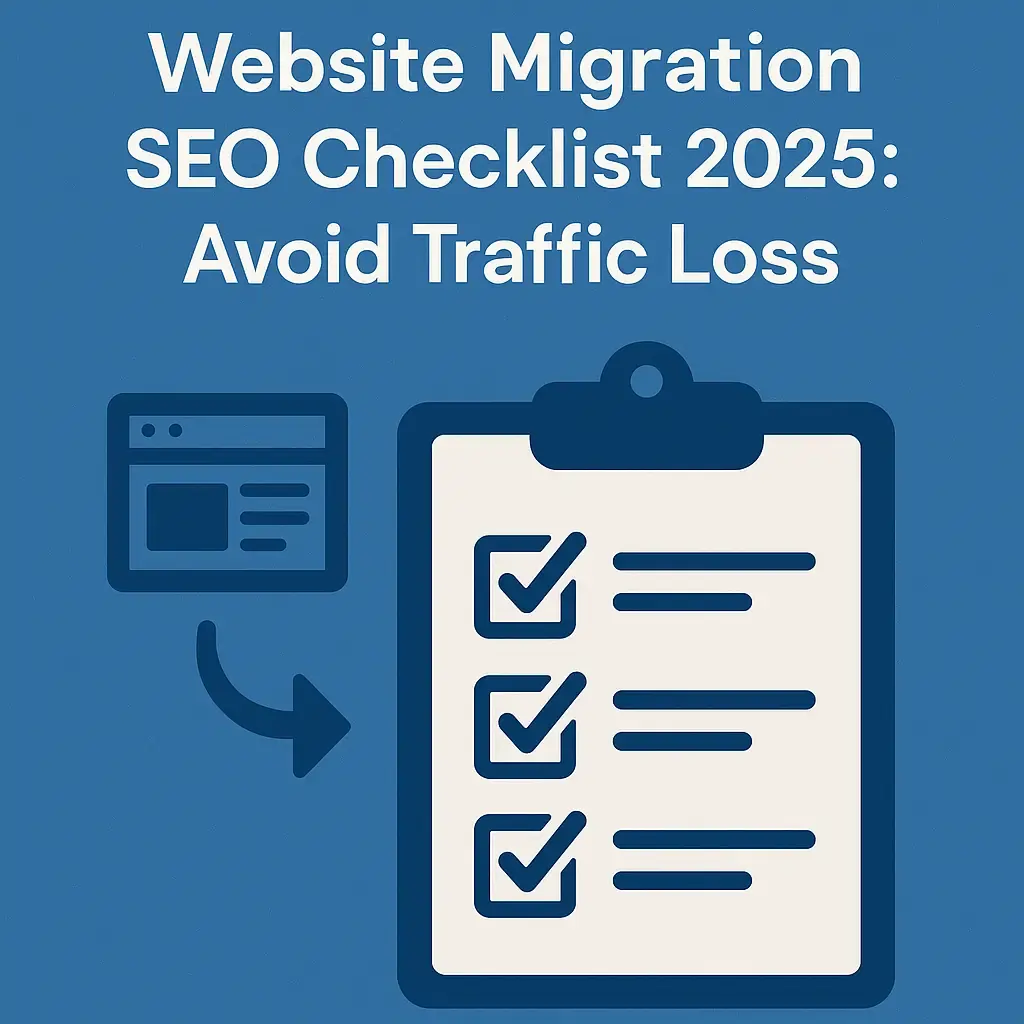Migrating your website to a new platform, domain, or structure can provide substantial strategic advantages. A successful website migration can significantly enhance your site’s performance, usability, and overall digital presence. If you’re seeking expert guidance, a reputable local SEO agency can help navigate these complexities. However, website migrations also carry inherent SEO risks, including substantial traffic losses and severe ranking declines if not managed precisely.
By following a structured, meticulous website migration SEO checklist, your business can confidently navigate these changes, protecting hard-earned rankings and organic traffic throughout the migration process. This expert-level guide delivers a complete 2025 checklist with actionable steps and strategic insights to ensure seamless website migration without compromising your SEO success. This comprehensive guide forms a critical part of your overall local SEO strategy.
Understanding the Importance of Website Migration SEO in 2025
In 2025, Google’s algorithms have grown increasingly sophisticated, prioritizing user experience, site structure, mobile-friendliness, and page speed. A website migration dramatically impacts your site’s SEO visibility, rankings, and traffic stability. Even minor oversights can cause lasting harm.
Therefore, proactively preparing a detailed website migration SEO strategy is crucial. By closely following this comprehensive checklist, you minimize risk and maintain consistent, high-ranking visibility before, during, and after migration.
Complete Website Migration SEO Checklist 2025
Pre-Migration Phase Checklist
Define Clear Migration Objectives
Clearly outline specific objectives, reasons, and expected outcomes for your migration. Establish benchmarks, timelines, and success criteria upfront to guide your strategic decisions.
Perform a Comprehensive Pre-Migration SEO Audit
Conduct a thorough SEO audit documenting current rankings, site structure, traffic patterns, backlink profile, and technical SEO health. Utilizing the right local SEO tools can significantly streamline this process and help you use these insights to measure migration effectiveness later.
Create and Document URL Mapping Strategy
Carefully map old URLs to their new counterparts. Maintain a detailed, precise document outlining redirects to avoid broken links, ranking loss, and confused users. For official guidance on this process, refer to Google’s documentation on site moves with URL changes.
Benchmark key performance metrics.
Document current rankings, organic traffic, conversion rates, bounce rates, and engagement metrics. Establish clear benchmarks for post-migration comparisons.
Technical SEO Preparation Checklist
Set Up Staging Environment
Always migrate your site to a staging environment first. Fully test and validate technical changes, URL structure, and content migration in this controlled environment before going live.
Implement Correct 301 Redirects
Precisely set up 301 permanent redirects from old URLs to corresponding new pages. This maintains ranking signals, prevents 404 errors, and ensures seamless user navigation.
Optimize Robots.txt and XML sitemaps.
Update your robots.txt file to avoid blocking essential pages. Submit updated XML sitemaps to Google Search Console, clearly communicating your new site structure to search engines.
Ensure Mobile and Core Web Vitals Optimization
Prioritize mobile-friendliness, responsive design, fast load times, and optimized Core Web Vitals scores. This is especially vital for mobile optimization for local SEO. Google significantly rewards sites delivering exceptional technical experiences.
Confirm HTTPS Implementation and Security
Implement HTTPS across all migrated pages and confirm proper SSL configuration. Secure connections are a key ranking factor and vital to maintaining user trust.
Content and On-Page SEO Migration Checklist
Audit and Optimize Migrated Content
Review and optimize all migrated content carefully. Update outdated information, ensure high-quality content standards, and incorporate keyword optimizations strategically into new pages.
Preserve and Optimize Meta Tags and Schema Markup
Ensure accurate migration of meta titles, meta descriptions, and structured data markup (schema). Properly formatted schema markup helps maintain rich snippet visibility post-migration.
Optimize Internal Linking and Navigation
Confirm internal linking accuracy. Ensure new navigation and site structure remain intuitive, crawlable, and effectively structured to pass ranking signals throughout your new site.
Check for Duplicate Content and Indexing Issues
Conduct a thorough duplicate content audit post-migration. Utilize canonical tags appropriately to avoid indexing conflicts or dilution of page authority.
Post-Migration Launch Checklist
Immediately Test Redirect Implementation
Immediately after launching, thoroughly test redirects for accuracy, functionality, and effectiveness. Address broken redirects swiftly to avoid ranking loss or negative user experiences.
Validate Crawlability and Indexing with Google Search Console
Actively monitor Google Search Console post-launch for indexing issues, crawl errors, and sitemap accuracy. Promptly address any identified problems to maintain strong rankings.
Closely Monitor Key SEO Metrics and Rankings
Monitor organic rankings, traffic, conversions, and engagement continuously post-migration. Rapidly addressing declines or fluctuations ensures swift SEO recovery and stabilization.
Post-Migration Long-Term SEO Maintenance Checklist
Regularly Update and Refine Content
Continually optimize existing content post-migration. Regular updates, content improvements, and strategic keyword optimization maintain long-term SEO effectiveness.
Continuously Optimize Technical Performance
Regularly test your site’s mobile-friendliness, Core Web Vitals scores, page speed, and technical health. Proactive technical maintenance ensures sustained competitive SEO performance.
Proactively Manage and Grow Your Backlink Profile
Post-migration, actively build high-quality backlinks from authoritative sites. Continuously maintain existing backlinks, resolving any broken links promptly to sustain domain authority.
Monitor Competitive Performance and SEO Opportunities
Continually benchmark competitive SEO strategies, keyword trends, and emerging market opportunities. Adapting proactively maintains long-term ranking visibility and strategic competitive advantage.
Common Website Migration SEO Pitfalls to Avoid in 2025
To minimize migration risk, strategically avoid these common pitfalls:
- Neglecting meticulous redirect planning and validation
- Launching without comprehensive pre-migration audits and benchmarking
- Failing to monitor and resolve post-launch indexing and crawl errors immediately
- Overlooking consistent technical optimization and mobile-friendliness
Avoiding these errors significantly reduces risk and sustains your site’s visibility and traffic post-migration.
Key Metrics to Measure SEO Migration Success
Carefully track these critical metrics to measure your migration’s success and proactively refine your strategy:
- Organic traffic trends and engagement metrics post-launch
- Keyword rankings and overall visibility changes
- Bounce rate, session duration, and user experience metrics
- Conversion rates specifically from organic search traffic
- Technical SEO metrics such as indexing speed, crawl errors, and page speed scores
Regularly monitoring these metrics ensures proactive problem identification, swift resolution, and sustained SEO effectiveness.
Anticipating Future SEO Trends for Successful Website Migrations
Website migrations must anticipate and adapt proactively to emerging SEO trends:
- Growing emphasis on mobile performance, responsive design, and fast-loading experiences
- Increasing importance of structured data markup for enhanced visibility in rich search results
- Advanced search intent analysis and personalized search results
- Continuous improvements to Core Web Vitals as key ranking factors
Staying strategically aware ensures future-proofing your website’s SEO success post-migration.
Strategic Recommendations for Optimal Website Migration SEO Results
To achieve optimal results, strategically approach your website migration by:
- Conducting detailed planning, including thorough audits, URL mapping, and clear benchmarks
- Closely managing technical migration aspects, emphasizing redirects, indexing, and technical optimization
- Carefully optimizing content quality, internal linking, and user navigation for long-term SEO success
- Continuously monitoring, measuring, and refining your strategy post-launch based on key performance metrics
Safeguarding Your SEO Visibility During Website Migrations
A meticulously planned, strategically executed website migration protects your SEO investments, maintaining consistent rankings and traffic stability. This is crucial for small businesses looking to maximize their local SEO benefits.
In a competitive online landscape, careful migration management and proactive SEO maintenance ensure long-term visibility, growth, and competitive advantage, positioning your site prominently in search results now and into the future.

